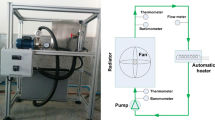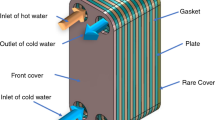Abstract
The convective heat transfer coefficient (CHTC) of a fluid is one of the most effective factors on the performance of a fluid in heat transfer equipment. Due to the higher conductivity of metals than that of liquids, solid metal particles can be mixed in a fluid to improve the CHTC of it. According to recent advances in nanotechnology, using nanofluids is one of the popular methods to increase heat transfer in heat exchangers. In this paper, the main influence factors on increasing the CHTC of the nanofluid, including flow rate and nanofluid concentration, were investigated. For this study, all tests were carried out in the Reynolds range of 10,000 to 31,500 which are definitely in turbulent regime. Furthermore, in order to reduce the number of tests, Design–Expert software using central composite method has been employed. The results indicate that increasing the Reynolds leads to an increase in the CHTC and a decrease in the friction factor. In addition, it was shown that at a constant Reynolds, carbon nanofluid with concentration of 0.21 mass% has about 40.7% higher CHTC than pure water. The variation of friction factor was investigated too and was found that this parameter is increased by increasing the nanofluid concentration and decreasing the Reynolds number. The entropy generation due to heat transfer and friction factor was assessed and finally showed that in 0.21 mass% where the maximum Nusselt is available, the entropy generation is the lowest. By calculating the Bejan number, the portions of heat and friction factors in generating entropy were determined.












Similar content being viewed by others
References
Noghrehabadi A, Saffarian MR, Pourrajab R, Ghalambaz M. Entropy analysis for nanofluid flow over a stretching sheet in the presence of heat generation/absorption and partial slip. J Mech Sci Technol. 2013;27(3):927–37.
Firoozzadeh M, Shiravi AH, Shafiee M. Experimental study on photovoltaic cooling system integrated with carbon nano fluid. J Solar Energy Res. 2018;3(4):287–92.
Saffarian MR, Moravej M, Doranehgard MH. Heat transfer enhancement in a flat plate solar collector with different flow path shapes using nanofluid. Renew Energy. 2020;146:2316–29.
Firoozzadeh M, Shiravi AH, Shafiee M. Different methods of using phase change materials (PCMs) as coolant of photovoltaic modules: a review. J Energy Manag Technol. 2020;4(3):30–6. https://doi.org/10.22109/jemt.2020.174137.1161.
AL-Musawi AIA, Taheri A, Farzanehnia A, Sardarabadi M, Passandideh-Fard M. Numerical study of the effects of nanofluids and phase-change materials in photovoltaic thermal (PVT) systems. J Therm Anal Calorim. 2019;137(2):623–36.
Moravej M, Saffarian MR, Li LK, Doranehgard MH, Xiong Q. Experimental investigation of circular flat-panel collector performance with spiral pipes. J Therm Anal Calorim. 2020;140:1229–36. https://doi.org/10.1007/s10973-019-08879-1.
Poshtiri AH, Taghiyari HR, Karimi AN. Fire-retarding properties of nano-wollastonite in solid wood. Philipp Agric Sci. 2014;97(1):52–9.
Mousavi F, Taherpour AA. Sensitization of copper oxide nanoparticles by Victoria Blue R for dye-sensitized solar cells: a DFT study. Adv Nanochem. 2019;1(1):12–6.
Seyfoori A, Naghib SM, Molaabasi F. Inhibitory effect comparison of the needle, spherical, and mesoporous hydroxyapatite nanoparticles on MCF-7 breast cancer cell line proliferation: an in vitro assay. Adv Nanochem. 2020;2(1):11–4.
Taherpour AA, Hassani Daramroudi A, Kariminya R. Theoretical study of diffusion flow of anticancer medicines through single-wall armchair (10, 10) carbon nanotube. Adv Nanochem. 2019;1(2):56–61.
Firouzfar E, Soltanieh M, Noie S, Saidi M. Investigation of heat pipe heat exchanger effectiveness and energy saving in air conditioning systems using silver nanofluid. Int J Environ Sci Technol. 2012;9(4):587–94.
Xian HW, Sidik NAC, Najafi G. Recent state of nanofluid in automobile cooling systems. J Therm Anal Calorim. 2019;135(2):981–1008.
Eastman JA, Choi S, Li S, Yu W, Thompson L. Anomalously increased effective thermal conductivities of ethylene glycol-based nanofluids containing copper nanoparticles. Appl Phys Lett. 2001;78(6):718–20.
Jung J-Y, Oh H-S, Kwak H-Y, editors. Forced convective heat transfer of nanofluids in microchannels. In: ASME 2006 International Mechanical Engineering Congress and Exposition; 2006: American Society of Mechanical Engineers.
Yu W, Xie H, Chen L, Li Y. Investigation of thermal conductivity and viscosity of ethylene glycol based ZnO nanofluid. Thermochim Acta. 2009;491(1–2):92–6.
Kasaeian AB, Nasiri S. Convection heat transfer modeling of nano-fluid Tio2 using different viscosity theories. Int J Nanosci Nanotechnol. 2015;11(1):45–51.
Pak BC, Cho YI. Hydrodynamic and heat transfer study of dispersed fluids with submicron metallic oxide particles. Exp Heat Transf Int J. 1998;11(2):151–70.
Shiravi AH, Firoozzadeh M, Bostani H, Shafiee M, Bozorgmehrian M. Experimental study on carbon nanofluid pressure drop and pumping power. Adv Nanochem. 2020;2(1):27–31. https://doi.org/10.22126/anc.2019.4418.1015.
Xuan Y, Li Q. Investigation on convective heat transfer and flow features of nanofluids. J Heat Transf. 2003;125(1):151–5.
Haghighi EB, Saleemi M, Nikkam N, Khodabandeh R, Toprak MS, Muhammed M, et al. Accurate basis of comparison for convective heat transfer in nanofluids. Int Commun Heat Mass Transf. 2014;52:1–7.
Fotukian S, Esfahany MN. Experimental study of turbulent convective heat transfer and pressure drop of dilute CuO/water nanofluid inside a circular tube. Int Commun Heat Mass Transf. 2010;37(2):214–9.
Maı̈ga SEB, Nguyen CT, Galanis N, Roy G. Heat transfer behaviours of nanofluids in a uniformly heated tube. Superlattices Microstruct. 2004;35(3):543–57.
El Bécaye MS, Tam Nguyen C, Galanis N, Roy G, Maré T, Coqueux M. Heat transfer enhancement in turbulent tube flow using Al2O3 nanoparticle suspension. Int J Numer Methods Heat Fluid Flow. 2006;16(3):275–92.
Behzadmehr A, Saffar-Avval M, Galanis N. Prediction of turbulent forced convection of a nanofluid in a tube with uniform heat flux using a two phase approach. Int J Heat Fluid Flow. 2007;28(2):211–9.
Bahiraei M, Mazaheri N, Bakhti A. Irreversibility characteristics of nanofluid flow under chaotic advection in a minichannel for different nanoparticle types. J Taiwan Inst Chem Eng. 2018;88:25–36.
Karami M, Shirani E, Avara A. Analysis of entropy generation, pumping power, and tube wall temperature in aqueous suspensions of alumina particles. Heat Transf Res. 2012;43(4):327–42. https://doi.org/10.1615/HeatTransRes.2012004077.
Falahat A. Entropy generation analysis of nanofluid flow in Coiled tube heat exchanger under laminar flow. Elixir Mech Eng. 2012;51:10674–6.
Zamzamian A. Entropy generation analysis of EG—Al2O3 nanofluid flows through a helical pipe. Int J Nanosci Nanotechnol. 2014;10(2):103–10.
Khorasanizadeh H, Nikfar M, Amani J. Entropy generation of Cu–water nanofluid mixed convection in a cavity. Eur J Mech B Fluids. 2013;37:143–52. https://doi.org/10.1016/j.euromechflu.2012.09.002.
Mahian O, Kianifar A, Kleinstreuer C, Moh’d AA-N, Pop I, Sahin AZ, et al. A review of entropy generation in nanofluid flow. Int J Heat Mass Transf. 2013;65:514–32.
Falahat A, Shabani M, Saffarian MR. Entropy generation of pseudo-plastic non-Newtonian nanofluids in circular duct under constant wall temperature. J Mech Eng Technol. 2018;10(1):1–10.
Malvandi A, Ganji DD. Fully developed flow and heat transfer of nanofluids inside a vertical annulus. J Braz Soc Mech Sci Eng. 2015;37(1):141–7. https://doi.org/10.1007/s40430-014-0139-x.
Hussien AA, Yusop NM, Moh’d AA-N, Abdullah MZ, Janvekar AA, Elnaggar MH. Numerical study of heat transfer enhancement using Al2O3–graphene/water hybrid nanofluid flow in mini tubes. Iran J Sci Technol Trans A Sci. 2019;43(4):1989–2000.
Hussien AA, Yusop NM, Abdullah MZ, Al-Nimr MDA, Khavarian M. Study on convective heat transfer and pressure drop of MWCNTs/water nanofluid in mini-tube. J Therm Anal Calorim. 2019;135(1):123–32. https://doi.org/10.1007/s10973-018-7234-7.
Alempour SM, Arani AAA, Najafizadeh MM. Numerical investigation of nanofluid flow characteristics and heat transfer inside a twisted tube with elliptic cross section. J Therm Anal Calorim. 2020:1–21.
Raei B, Shahraki F, Jamialahmadi M, Peyghambarzadeh SM. Experimental study on the heat transfer and flow properties of γ-Al2O3/water nanofluid in a double-tube heat exchanger. J Therm Anal Calorim. 2017;127(3):2561–75. https://doi.org/10.1007/s10973-016-5868-x.
Safi M, Ghozatloo A, Hamidi A, Shariaty-Niassar M. Calculation of heat transfer coefficient of MWCNT-TiO2 nanofluid in plate heat exchanger. Int J Nanosci Nanotechnol. 2014;10(3):153–62.
Mahian O, Mahmud S, Heris SZ. Analysis of entropy generation between co-rotating cylinders using nanofluids. Energy. 2012;44(1):438–46.
Varzaneh AA, Toghraie D, Karimipour A. Comprehensive simulation of nanofluid flow and heat transfer in straight ribbed microtube using single-phase and two-phase models for choosing the best conditions. J Therm Anal Calorim. 2019. https://doi.org/10.1007/s10973-019-08381-8.
Sajid MU, Ali HM, Sufyan A, Rashid D, Zahid SU, Rehman WU. Experimental investigation of TiO2–water nanofluid flow and heat transfer inside wavy mini-channel heat sinks. J Therm Anal Calorim. 2019;137(4):1279–94. https://doi.org/10.1007/s10973-019-08043-9.
Alipour Lalami A, Hassanzadeh Afrouzi H, Moshfegh A. Investigation of MHD effect on nanofluid heat transfer in microchannels. J Therm Anal Calorim. 2019;136(5):1959–75. https://doi.org/10.1007/s10973-018-7851-1.
Akbari OA, Khodabandeh E, Kahbandeh F, Toghraie D, Khalili M. Numerical investigation of heat transfer of nanofluid flow through a microchannel with heat sinks and sinusoidal cavities by using novel nozzle structure. J Therm Anal Calorim. 2019;138(1):737–52.
Khorasanizadeh H, Sepehrnia M, Sadeghi R. Three dimensional investigations of inlet/outlet arrangements and nanofluid utilization effects on a triangular microchannel heat sink performance. Modares Mech Eng. 2016;16(12):27–38.
Salimi M, Peyghambarzadeh SM, Hashemabadi SH, Chabi A. Experimental investigation of convective heat transfer of Al2O3/water nanofluid through the micro heat exchanger. Modares Mech Eng. 2015;15(2):270–80.
Khorasanizadeh H, Amani J, Nikfar M. Numerical investigation of Cu–water nanofluid natural convection and entropy generation within a cavity with an embedded conductive baffle. Scientia Iranica. 2012;19(6):1996–2003.
Heris SZ, Pour MB, Mahian O, Wongwises S. A comparative experimental study on the natural convection heat transfer of different metal oxide nanopowders suspended in turbine oil inside an inclined cavity. Int J Heat Mass Transf. 2014;73:231–8.
Janssen L, Hoogendoorn C. Laminar convective heat transfer in helical coiled tubes. Int J Heat Mass Transf. 1978;21(9):1197–206.
Xin R, Ebadian M. The effects of Prandtl numbers on local and average convective heat transfer characteristics in helical pipes. J Heat Transf. 1997;119(3):467–73.
Mori Y, Nakayama W. Study on forced convective heat transfer in curved pipes: (3rd report, theoretical analysis under the condition of uniform wall temperature and practical formulae). Int J Heat Mass Transf. 1967;10(5):681–95. https://doi.org/10.1016/0017-9310(67)90113-5.
Huang D, Fan S. Thermal conductivity of methane hydrate formed from sodium dodecyl sulfate solution. J Chem Eng Data. 2004;49(5):1479–82.
Absalan H, Zarei H. Synthesis of quaternary Cu(InxGa1–x) Se2 nanoparticles for photovoltaic applications using heating-up method. Iran J Sci Technol Trans A Sci. 2019;43(1):309–14.
Ghamari S, Nabitabar M, Ranjbar M. Study the properties of gadolinium-doped ceria nano-powders synthesized via sol–gel method with new precursors. Iran J Sci Technol Trans A Sci. 2018;42(4):1969–76.
Moghaddari M, Yousefi F. Syntheses, characterization, measurement and modeling viscosity of nanofluids containing OH-functionalized MWCNTs and their composites with soft metal (Ag, Au and Pd) in water, ethylene glycol and water/ethylene glycol mixture. J Therm Anal Calorim. 2019;135(1):83–96. https://doi.org/10.1007/s10973-018-7150-x.
Shafiee M, Akbari A. Optimization of UHMWPE/graphene nanocomposite preparation by single-supported Ziegler–Natta catalytic system via RSM. Polym Adv Technol. 2018;29(7):1889–94.
Fadavipoor E, Badri R, Kiasat A, Sanaeishoar H. CuO supported 1-methyl-3-(3-(trimethoxysilyl) propyl) imidazolium chloride (MTMSP-Im/Cl) nanoparticles as an efficient simple heterogeneous catalysts for synthesis of β-azido alcohols. J Iran Chem Soc. 2019;16(7):1451–8.
Paryani S, Ramazani SAA. Investigation of the combination of TiO2 nanoparticles and drag reducer polymer effects on the heat transfer and drag characteristics of nanofluids. Can J Chem Eng. 2018;96(6):1430–40.
Author information
Authors and Affiliations
Corresponding author
Additional information
Publisher's Note
Springer Nature remains neutral with regard to jurisdictional claims in published maps and institutional affiliations.
Rights and permissions
About this article
Cite this article
Shiravi, A.H., Shafiee, M., Firoozzadeh, M. et al. Experimental study on convective heat transfer and entropy generation of carbon black nanofluid turbulent flow in a helical coiled heat exchanger. J Therm Anal Calorim 145, 597–607 (2021). https://doi.org/10.1007/s10973-020-09729-1
Received:
Accepted:
Published:
Issue Date:
DOI: https://doi.org/10.1007/s10973-020-09729-1




